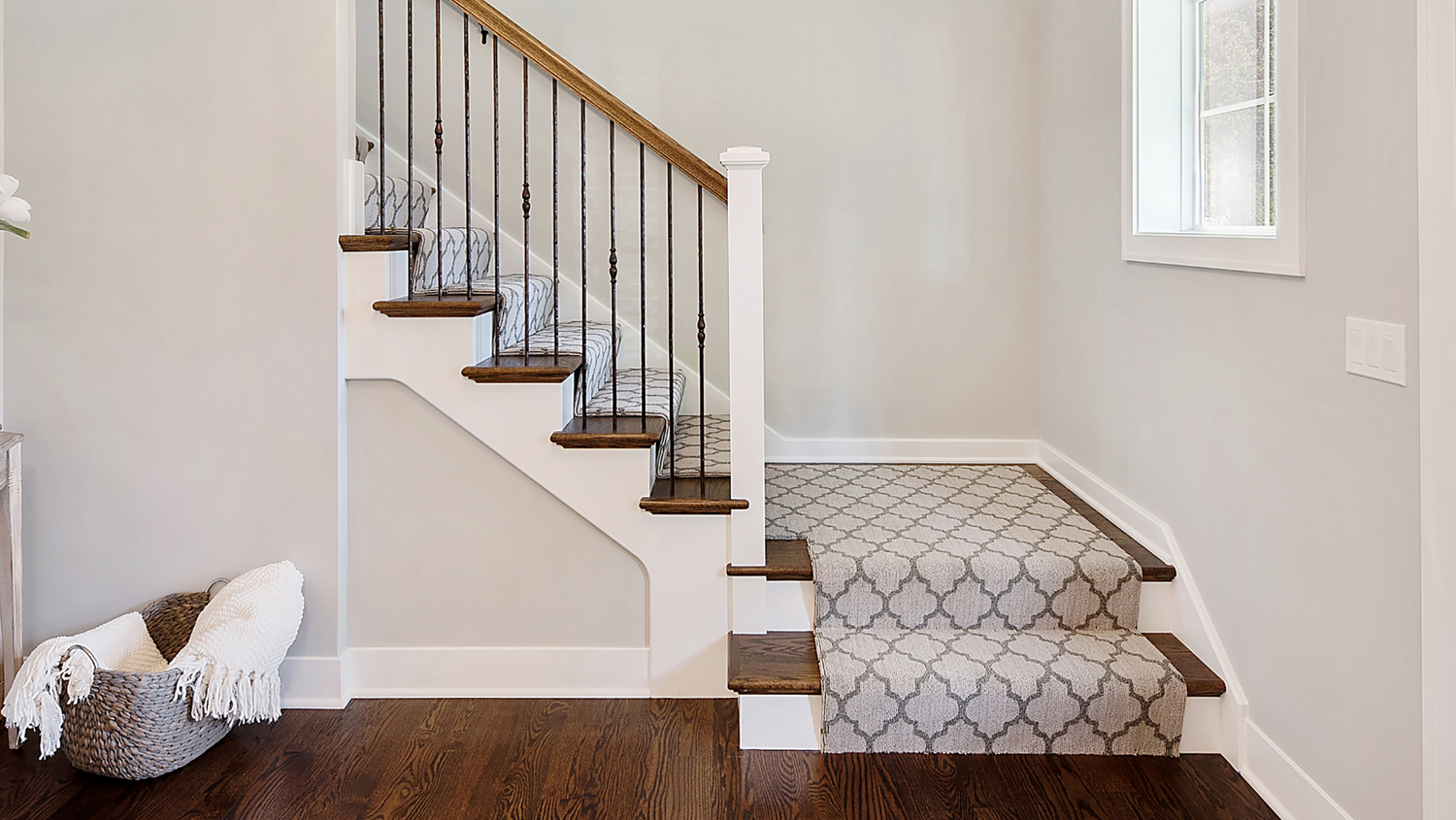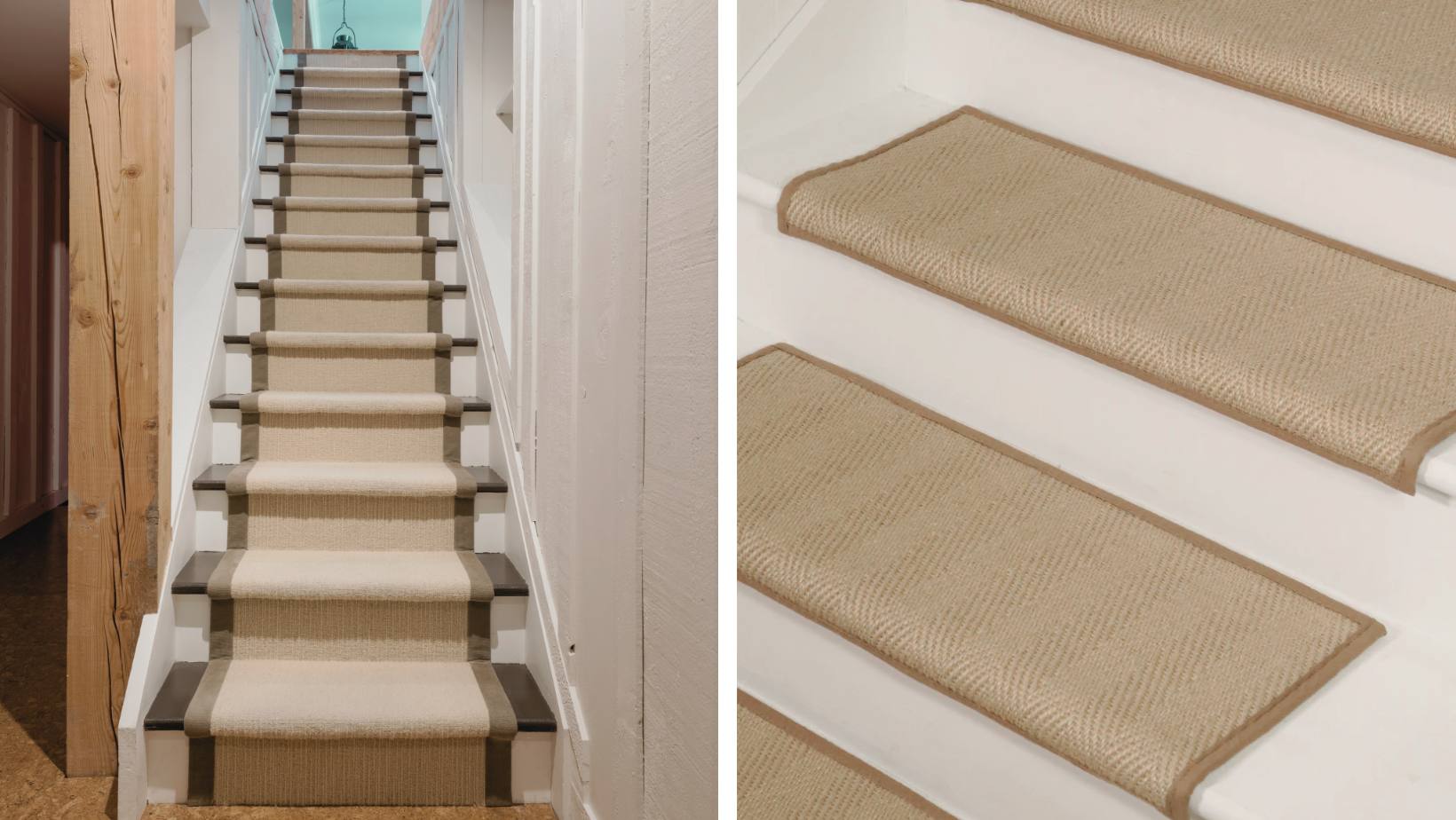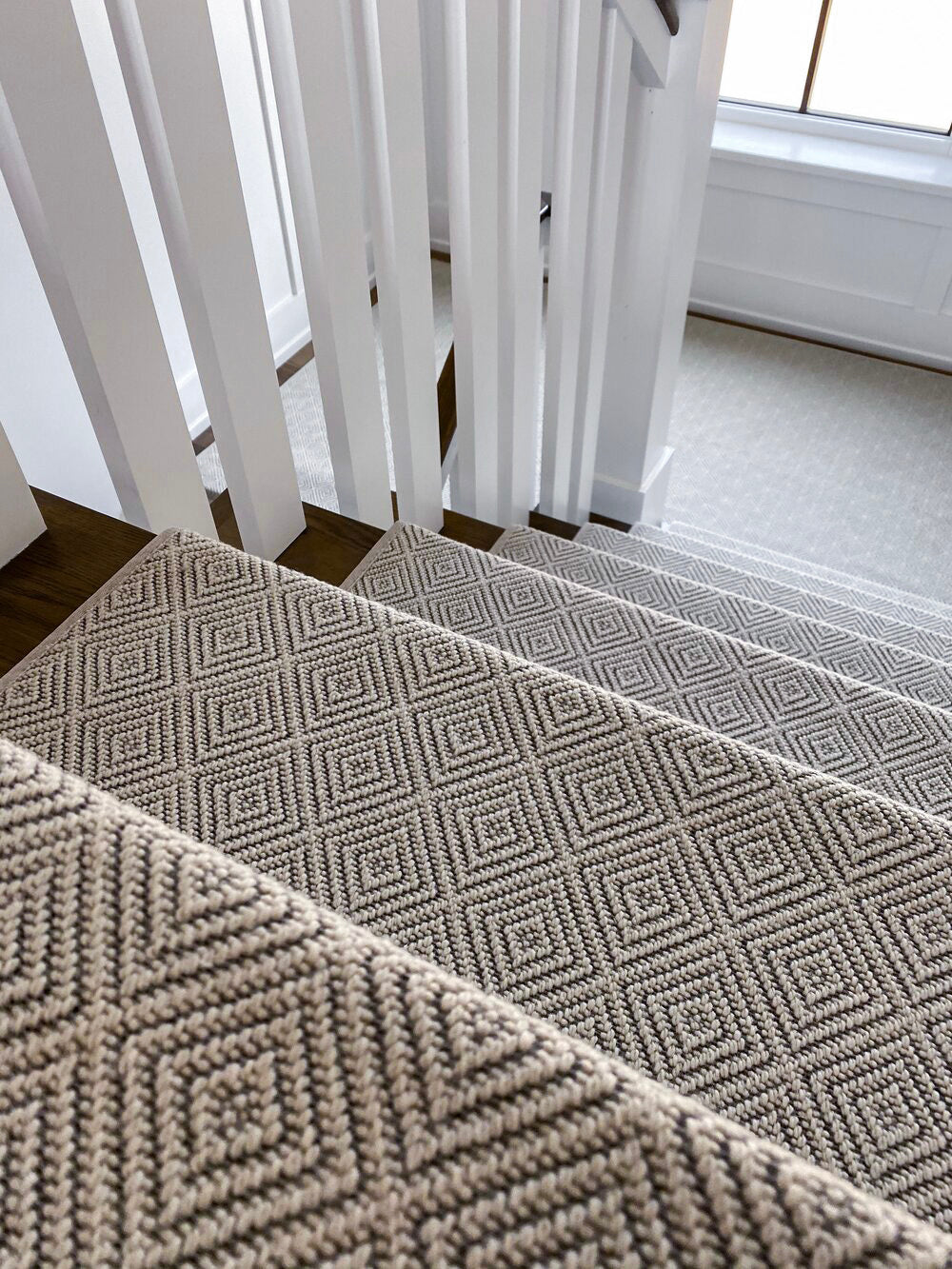A stair runner with landing is one continual piece of carpet that runs down the center of a staircase, covering only the walking areas of the stairs and the landing.
The runner not only provides a decorative touch but also helps to reduce noise, prevent slipping, and protect the stairs from wear and tear.
Not to be mistaken with Carpet Stair Treads, which are individual pieces of carpet, that are applied to each individual step.
Benefits of installing a stair runner with landing
- Adds a decorative element to the staircase
- Provides safety by reducing the risk of slipping
- Protects the stairs from damage and wear
- Reduces noise and echoes in the stairwell
Different types of materials for stair runners with landing
There are lots of runners for stairs ideas floating around.
Stair runners come in various materials, including wool, sisal, jute, and synthetic fibers.
Each material offers different levels of durability, comfort, and maintenance requirements.
When choosing a material for a stair runner with landing, it's essential to consider the amount of foot traffic the staircase receives and the overall design aesthetic of the home.
Difference between carpet stair runner and carpet stair treads
Carpet stair runners: are long, narrow strips of carpet that run down the center of a staircase, providing a decorative touch and helping to protect the stairs from wear and tear. They are typically installed with rods or tacks to keep them in place.
Carpet stair treads: are individual pieces of carpet that cover each individual stair, providing both a decorative and functional element by adding traction and reducing noise. They are usually installed with adhesive backing.
In summary, the main difference between carpet stair treads vs runner lies in their size and installation method, with runners being long, narrow strips and treads covering each individual stair.
Tools and Materials Needed for Installation
Before starting the installation of stair runners and landings, it's important to gather all the necessary tools and materials. Here's a list of what you'll need:
Tools:
- Measuring tape
- Utility knife
- Hammer
- Staple gun
- Carpet tucker
- Knee kicker
- Straightedge
- Heavy-duty scissors
Materials:
- Carpet runner
- Carpet pad
- Adhesive or tack strips
- Nails or staples
- Seam tape
- Carpet binding tape
Safety equipment:
- Knee pads
- Gloves
- Safety goggles
Measuring and Planning
Accurate measurements and careful planning are crucial for a successful installation of a stair runner with landing.
How to measure the staircase and landing for the carpet runner
Start by measuring the width and length of each tread and riser, as well as the landing. It's important to account for any curves or turns in the staircase to ensure the runner fits properly.
Tips for planning the layout and design
Consider the overall design scheme of the home and choose a runner that complements the existing decor. Additionally, plan the placement of the runner to ensure it aligns with the center of the staircase and covers the landing seamlessly.
Calculating the amount of carpet needed for the installation
To determine the amount of carpet needed, measure the total length of the staircase and add extra for trimming and finishing. It's also important to consider the width of the runner and any pattern repeats when calculating the required yardage.
Preparing the Stairs and Landing
Before installing the carpet runner, it's essential to prepare the stairs and landing to ensure a smooth and secure application.
Cleaning and preparing the stairs and landing for installation
Thoroughly clean the stairs and landing to remove any dirt, dust, or debris. This will ensure a clean surface for the carpet to adhere to and prevent any imperfections from showing through.
Repairing any damages or imperfections on the staircase
Inspect the stairs for any damages, such as loose treads or protruding nails, and make the necessary repairs before installing the runner. This will help ensure a flat and stable surface for the carpet.
Applying adhesive or tack strips for securing the carpet runner
Use adhesive or tack strips to secure the carpet runner to the stairs and landing. Adhesive is typically used for wooden stairs, while tack strips are used for concrete or metal surfaces.
Installing the Carpet Runner
With the stairs and landing prepared, it's time to install the carpet runner.
Step-by-step instructions for installing the carpet runner on the stairs and landing
- Start by securing the carpet pad to the stairs and landing using adhesive or staples.
- Position the carpet runner at the base of the stairs and use a knee kicker to stretch and secure it in place.
- Use a carpet tucker and straightedge to ensure the edges are neatly tucked and secured along the sides of the stairs.
- Trim any excess carpet and finish the edges with binding tape for a professional look.
Techniques for securing the carpet runner in place
Using a knee kicker and carpet tucker will help ensure the carpet runner is securely fastened to the stairs and landing. Additionally, using seam tape to join any seams will create a seamless and polished look.
Trimming and finishing the edges for a professional look
Carefully trim any excess carpet and use binding tape to finish the edges for a clean and polished appearance. This will also help prevent fraying and unraveling over time.
Maintenance and Care Tips
Once the carpet runner is installed, it's important to maintain and care for it properly to prolong its lifespan.
Tips for maintaining and cleaning the carpet stair runner with landing
Regular vacuuming and spot cleaning will help keep the carpet runner looking fresh and clean. Additionally, consider professional cleaning every few years to remove deep-seated dirt and stains.
How to address common issues such as stains or wear and tear
For stains, promptly blot the affected area with a clean cloth and mild detergent. Avoid rubbing the stain, as this can cause it to set further into the carpet fibers. For wear and tear, consider re-stretching the carpet runner if it becomes loose or wrinkled.
Recommendations for prolonging the lifespan of the carpet runner
To prolong the lifespan of the carpet runner, consider using carpet protectors on high-traffic areas and removing shoes before walking on the carpet. Additionally, rotate furniture periodically to prevent uneven wear patterns.
Conclusion
A well-installed stair runner with landing not only adds a decorative touch to the staircase but also provides safety, reduces noise, and protects the stairs from wear and tear. It's a practical and stylish addition to any home, and with the right knowledge and preparation, homeowners can tackle this project with confidence.



